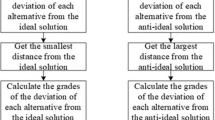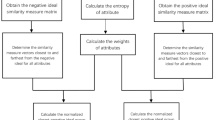Abstract
In recent years, different higher order fuzzy sets have been introduced to better handle the uncertainty in many practical decision making and data mining problems. The recent proposal of higher order fuzzy set is q-rung picture fuzzy set (q-RPFS) modeled by three parameters positive, negative, and neutral membership function. One of the important topics in q-RPFS is distance measures which play a crucial role in many multi criteria decision making methods and data mining applications. In this paper, we introduce a novel distance measure for q-RPFS which is the combination of q-rung orthopair fuzzy set (q-ROFS) and picture fuzzy set (PFS). The proposed distance measure is used in q-rung picture fuzzy (q-RPF) ELECTRE integrated with TOPSIS as a new approach for group decision making in q-RPF environment. To demonstrate the effectiveness of our proposed method, a comparison is made with the q-RPF approach based on aggregation operators using a numerical example for decision making problem. Furthermore, the proposed distance measure is utilized in a q-RPF k nearest neighborhood (kNN) algorithm for classification. The proposed classification algorithm is applied to twenty UCI machine learning classification data sets. A comparison with other algorithms is performed and the results show that the proposed classification algorithm has the highest average classification accuracy.




Similar content being viewed by others
References
Ai Z, Xu Z, Yager RR, Ye J (2020) q-Rung Orthopair Fuzzy Archimedean t-Norms and t-Conorms and their application. IEEE T Fuzzy Syst. https://doi.org/10.1109/tfuzz.2020.2965887
Alcalá-Fdez J, Fernández A, Luengo J, Derrac J, García S, Sánchez L, Herrera F (2011) Keel data-mining software tool: data set repository, integration of algorithms and experimental analysis framework. J Mult-Valued Log Soft Comput 17:255–287
Alcalá-Fdez J et al (2009) KEEL: a software tool to assess evolutionary algorithms for data mining problems. Soft Comput 13:307–318
Arif M, Akram MU (2010) Pruned fuzzy K-nearest neighbor classifier for beat classification. J Biomed Sci Eng 3:380
Atanassov KT (1986) Intuitionistic fuzzy sets. Fuzzy Sets Syst 20:87–96. https://doi.org/10.1016/S0165-0114(86)80034-3
Atanassov KT (ed) (1999) Intuitionistic Fuzzy Sets. In: Intuitionistic Fuzzy Sets: Theory and Applications. Physica-Verlag HD, Heidelberg, pp 1–137. https://doi.org/10.1007/978-3-7908-1870-3_1
Boran FE, Akay D (2014) A biparametric similarity measure on intuitionistic fuzzy sets with applications to pattern recognition. Inf Sci 255:45–57. https://doi.org/10.1016/j.ins.2013.08.013
Cover T, Hart P (1967) Nearest neighbor pattern classification. IEEE Trans Inf Theory 13:21–27
Cuong BC, Kreinovich V (2013) Picture fuzzy sets-a new concept for computational intelligence problems. In: 2013 Third world congress on information and communication technologies (WICT 2013). IEEE, pp 1–6
Dengfeng L, Chuntian C (2002) New similarity measures of intuitionistic fuzzy sets and application to pattern recognitions. Pattern Recogn Lett 23:221–225
Denouex T (1995) A k-nearest neighbor classification rule based on dempster-shafer theory. IEEE Trans Syst Man Cybern 25:804–813
Du WS (2018) Minkowski-type distance measures for generalized orthopair fuzzy sets. Int J Intell Syst 33:802–817
Dutta P (2017) Medical diagnosis via distance measures on picture fuzzy sets. AMSE J-AMSE IIETA Publ-2017-Ser: Adv A 54:657–672
Dutta P (2018) Medical diagnosis based on distance measures between picture fuzzy sets. Int J Fuzzy Syst Appl (IJFSA) 7:15–36
Grzegorzewski P (2004) Distances between intuitionistic fuzzy sets and/or interval-valued fuzzy sets based on the Hausdorff metric. Fuzzy Sets Syst 148:319–328
Guha D, Chakraborty D (2010) A theoretical development of distance measure for intuitionistic fuzzy numbers. Int J Math Math Sci 2010:949143. https://doi.org/10.1155/2010/949143
He J, Wang X, Zhang R, Li L (2019) Some q-rung picture fuzzy Dombi Hamy mean operators with their application to project assessment. Mathematics 7:468
Intarapaiboon P (2016) A hierarchy-based similarity measure for intuitionistic fuzzy sets. Soft Comput 20:1909–1919
Keller JM, Gray MR, Givens JA (1985) A fuzzy K-nearest neighbor algorithm. IEEE Trans Syst Man Cybern 15:580–585. https://doi.org/10.1109/tsmc.1985.6313426
Kuncheva L (1995) An intuitionistic fuzzy k-nearest neighbors rule. Notes Intuit Fuzzy Sets 1:56–60
Li L, Zhang R, Wang J, Shang X, Bai K (2018) A novel approach to multi-attribute group decision-making with q-rung picture linguistic information. Symmetry 10:172
Li Y, Cheng B (2009) An improved k-nearest neighbor algorithm and its application to high resolution remote sensing image classification. In: 2009 17th international conference on geoinformatics. IEEE, pp 1–4
Liang Z, Shi P (2003) Similarity measures on intuitionistic fuzzy sets. Pattern Recogn Lett 24:2687–2693
Liu P, Wang P (2018) Some q-rung orthopair fuzzy aggregation operators and their applications to multiple-attribute decision making. Int J Intell Syst 33:259–280
Lin M, Huang C, Xu Z (2020a) MULTIMOORA based MCDM model for site selection of car sharing station under picture fuzzy environment. Sustain Urban Areas 53:101873
Lin M, Li X, Chen L (2020b) Linguistic q-rung orthopair fuzzy sets and their interactional partitioned Heronian mean aggregation operators. Int J Intell Syst 35(2):217–249
Luo M, Zhao R (2018) A distance measure between intuitionistic fuzzy sets and its application in medical diagnosis. Artif Intell Med 89:34–39
Narukawa Y, Torra V (2006) Non-monotonic fuzzy measures and intuitionistic fuzzy sets. In: International conference on modeling decisions for artificial intelligence. Springer, pp 150-160
Peng X, Dai J (2017) Algorithm for picture fuzzy multiple attribute decision-making based on new distance measure. Int J Uncertain Quantif 7:177–187. https://doi.org/10.1615/Int.J.UncertaintyQuantification.2017020096
Peng X, Liu L (2019) Information measures for q-rung orthopair fuzzy sets. Int J Intell Syst 34:1795–1834
Pinar A, Boran FE (2020) A q-rung orthopair fuzzy multi-criteria group decision making method for supplier selection based on a novel distance measure. Int J Mach Learn Cybern 11:1749–1780. https://doi.org/10.1007/s13042-020-01070-1
Rhee F-H, Hwang C (2003) An interval type-2 fuzzy K-nearest neighbor. In: The 12th IEEE International Conference On Fuzzy Systems, 2003. FUZZ'03. IEEE, pp 802–807
Shu X, Ai Z, Xu Z, Ye J (2019) Integrations of q-rung orthopair fuzzy continuous information. IEEE Trans Fuzzy Syst 27(10):1974–1985
Son LH (2016) Generalized picture distance measure and applications to picture fuzzy clustering. Appl Soft Comput 46:284–295
Son LH (2017) Measuring analogousness in picture fuzzy sets: from picture distance measures to picture association measures. Fuzzy Optim Decis Mak 16:359–378
Szmidt E, Kacprzyk J (2000) Distances between intuitionistic fuzzy sets. Fuzzy Sets Syst 114:505–518. https://doi.org/10.1016/S0165-0114(98)00244-9
Van Dinh N, Thao NX (2018) Some measures of picture fuzzy sets and their application in multi-attribute decision making. Int J Math Sci Comput (IJMSC) 4:23–41
Verma R, Sharma BD (2012) On generalized intuitionistic fuzzy divergence (relative information) and their properties. J Uncertain Syst 6:308–320
Wang P, Wang J, Wei G, Wei C (2019) Similarity measures of q-rung orthopair fuzzy sets based on cosine function and their applications. Mathematics 7:340
Wang W, Xin X (2005) Distance measure between intuitionistic fuzzy sets. Pattern Recogn Lett 26:2063–2069
Wei G (2017) Some cosine similarity measures for picture fuzzy sets and their applications to strategic decision making. Informatica 28:547–564
Wei G (2018) Some similarity measures for picture fuzzy sets and their applications. Iran J Fuzzy Syst 15:77–89
Wilson DL (1972) Asymptotic properties of nearest neighbor rules using edited data. IEEE Trans Syst Man Cybern 2:408–421. https://doi.org/10.1109/tsmc.1972.4309137
Wu M-C, Chen T-Y (2011) The ELECTRE multicriteria analysis approach based on Atanassov’s intuitionistic fuzzy sets. Expert Syst Appl 38(10):12318–12327
Xia M, Xu Z (2010) Some new similarity measures for intuitionistic fuzzy values and their application in group decision making. J Syst Sci Syst Eng 19:430–452
Xu Z, Chen J (2008) An overview of distance and similarity measures of intuitionistic fuzzy sets. Int J Uncertain Fuzziness Knowl-Based Syst 16:529–555
Xu Z, Yager RR (2009) Intuitionistic and interval-valued intutionistic fuzzy preference relations and their measures of similarity for the evaluation of agreement within a group. Fuzzy Optim Decis Making 8:123–139
Yager RR (2017) Generalized orthopair fuzzy sets. IEEE Trans Fuzzy Syst 25:1222–1230. https://doi.org/10.1109/Tfuzz.2016.2604005
Zadeh LA (1965) Fuzzy sets. Information control 8:338–353. https://doi.org/10.1016/S0019-9958(65)90241-X
Author information
Authors and Affiliations
Corresponding author
Additional information
Publisher's Note
Springer Nature remains neutral with regard to jurisdictional claims in published maps and institutional affiliations.
Rights and permissions
About this article
Cite this article
Pinar, A., Boran, F.E. A novel distance measure on q-rung picture fuzzy sets and its application to decision making and classification problems. Artif Intell Rev 55, 1317–1350 (2022). https://doi.org/10.1007/s10462-021-09990-2
Published:
Issue Date:
DOI: https://doi.org/10.1007/s10462-021-09990-2




